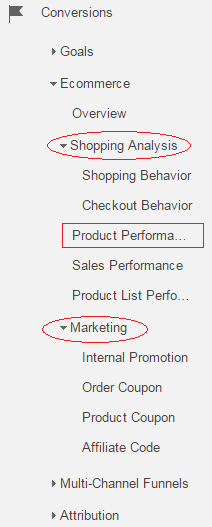What is Enhanced Ecommerce (Part 1/2)? In May 2014, the Enhanced Ecommerce beta was launched by Google Analytics. Every Google Analytics account is eligible to transfer to Enhanced Ecommerce since summer 2014. The new Enhanced Ecommerce analytics provides a lot of new insights and reports over the pre-purchase ecommerce behavior and the products and marketing actions performances. This is a remarkable evolution knowing that more and more people buy online. These new data and insights are becoming key for ecommerce players to take better decisions.
New ecommerce reports
With the Enhanced Ecommerce, new ecommerces reports are available in the Google Analytics interface: Reporting > Conversions > Ecommerce. These new reports give a much broader view on the purchasing behavior and the impact of marketing actions promoted on the website.
There are indeed two new categories of reports:

1. Shopping Analysis reports
The Shopping Analysis reports include reports about how successful your website is to make people buy online.
The first report called “Shopping Behavior Analysis” shows a detailed view of the customers shopping experience from the product view to the transaction. Many new metrics such as the shopping cart additions and removals are available in this report. For example, we are now able to compare the most viewed products with the most added-to-cart products.

The second report called “Checkout Behavior Analysis” shows a detailed view of the checkout process performances with many statistics for each step. It makes it much easier to identify bottlenecks in the purchase process. It is possible to track many options such as the delivery type or the payment method selected by the customer.
There is also an improved product performance report where you can find the following new metrics: the product refund amount, the cart-to-detail rate and the buy-to-detail rate.
2. Marketing reports
The second kind of new reports are the Marketing reports. They include reports about the performance of your Marketing actions such as promo banners displayed on your website, the use of promo codes or affiliate campaigns. Here are the new available reports:
- Internal promotion performances
- Order coupon performances
- Product coupon performances
- Affiliate coupon performances
One last new feature is the ability to create advanced segments based on ecommerce metrics such as visitors who abandoned the funnel at the “delivery address” step or visitors who selected the credit card as payment method. These new segments allow to go much further in the analysis of the online shopping experience.
Conclusion
We are happy to see that Google is putting more effort into e-commerce analysis, which will certainly benefit marketing decisions in the future. The shopping analysis reports allow to analyze a larger funnel from product views to transaction. Spotting cross- & upsell opportunities will be much easier. The marketing reports on the other hand will enable better measurement of marketing activities and promotion effectiveness.
Although the reports are focused on ecommerce there are also possibilities for other types of businesses. It is possible to use the Enhanced Ecommerce reports for any website, by translating its structure into a funnel view (even if there is no real online transaction).
Stay tune for the next article that will explain in details the technical implementation of Enhanced Ecommerce.
![]() written by Chloé Piérard
written by Chloé Piérard


